Wildflowers of the Adirondacks:
Painted Trillium (Trillium undulatum)
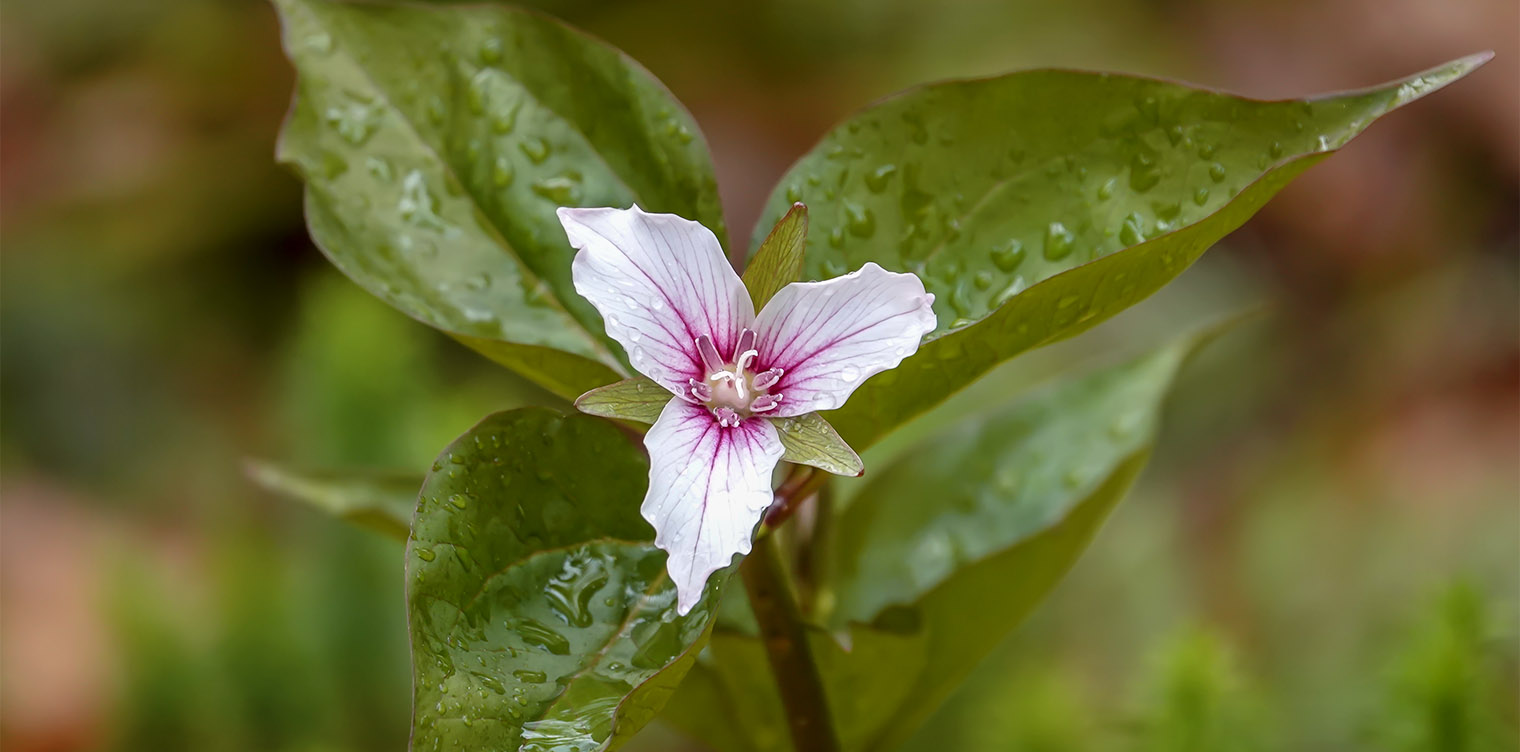
Painted Trillium (Trillium undulatum) is a wildflower that sports a single white flower, splashed with bright pink above three blue-green leaves. This species is a member of the Lily family. It is one of two common trilliums in the Adirondack region, the other being the Purple Trillium.
- The name "trillium" is from the Latin words "tri" (referring to the fact that the plant has three leaves and the flower has three parts) and "llium" (from the Latin liliaceous, referring to the funnel-shaped flower).
- The species name (undulatum) is from the Latin word meaning wavy-edged; this is a reference to the fact that the petals have wavy edges.
The plant is also referred to as Painted Lady (not to be confused with the Painted Lady butterfly) and Painted Wakerobin. The latter name reflects the fact that the species blooms about the same time the robins return in the spring.
Identification of Painted Trillium
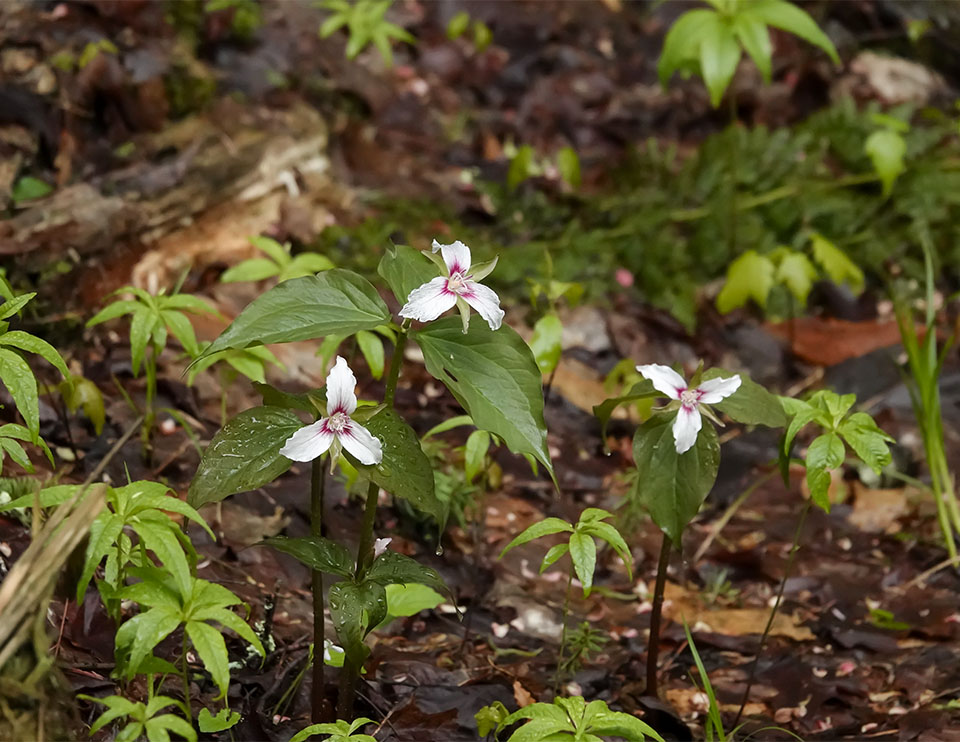
Painted Trilliums grow eight to 20 inches tall. There is a single whorl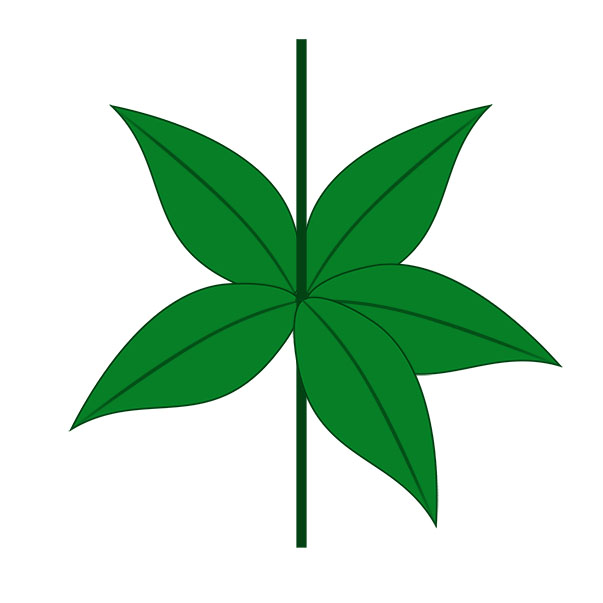 Whorled: Leaves arranged in a circle around a central point. of three leaves at the top of the stem. Each bluish-green, waxy leaf is 2½ to five inches long, broadly rounded at the base and tapering to a point.
Whorled: Leaves arranged in a circle around a central point. of three leaves at the top of the stem. Each bluish-green, waxy leaf is 2½ to five inches long, broadly rounded at the base and tapering to a point.
The single flower appears on the top of the stalk, just above the whorl of three leaves. The flower is usually 2 inches wide. The wavy-edged petals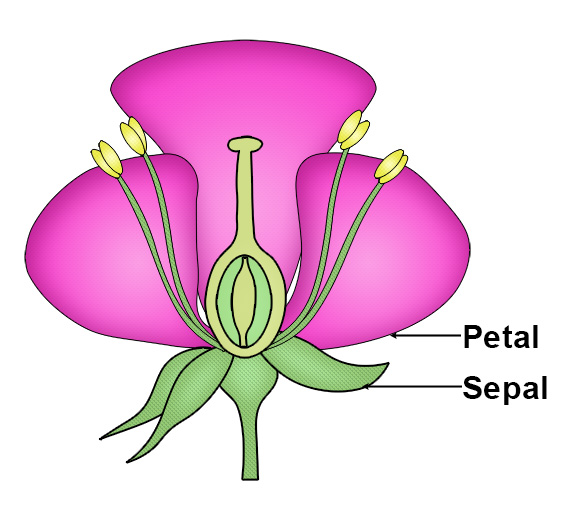 Petals: Modified leaves that surround the reproductive parts of flowers. Petals are often brightly colored or unusually shaped to attract pollinators. are lance-shaped
Petals: Modified leaves that surround the reproductive parts of flowers. Petals are often brightly colored or unusually shaped to attract pollinators. are lance-shaped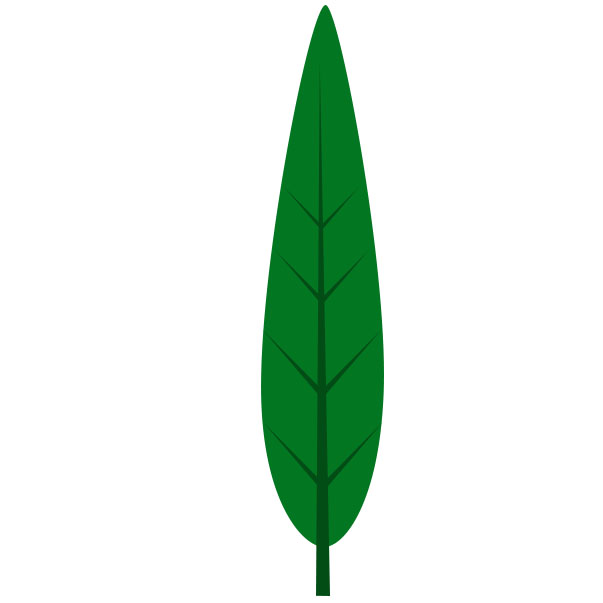 Lanceolate: A leaf shaped like a lance head, tapering to a point at each end. and have a tapered, pointed tip. The flower is white, with an inverted, deep pink V at the base of each petal. The flower has three green sepals
Lanceolate: A leaf shaped like a lance head, tapering to a point at each end. and have a tapered, pointed tip. The flower is white, with an inverted, deep pink V at the base of each petal. The flower has three green sepals.gif) Sepals: The parts that look like little green leaves and cover the outside of a flower bud to protect the flower before it opens. and six pink-tipped stamens
Sepals: The parts that look like little green leaves and cover the outside of a flower bud to protect the flower before it opens. and six pink-tipped stamens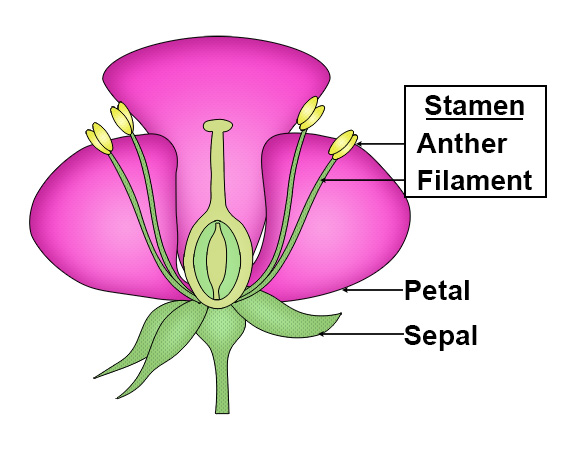 Stamen: The male part of the flower, made up of the filament and anther.. Flowers appear when the plant is 4 to 7 years old or older.
Stamen: The male part of the flower, made up of the filament and anther.. Flowers appear when the plant is 4 to 7 years old or older.
In the Adirondack Mountains, Painted Trilliums usually bloom in May. A tally of flowering dates for the upland Adirondack areas compiled by Michael Kudish, based on data collected from the early seventies to the early nineties, lists the earliest flower date as 26 April, the median date as 9 May, and the latest date as 3 June. Flowering dates from Adirondack Park observations on iNaturalist suggest a similar bloom pattern, with Painted Trilliums in flower from early May through the first week in June. At higher elevations, Painted Trilliums bloom about three weeks later.
The flower is followed by fruit in early fall. The fruit is a fleshy, berry-like capsule that starts off green and changes to bright red.
Uses of Painted Trillium
The Painted Trillium has very limited human uses. Although one source claims that the leaves are edible when cooked, another indicates that the fruits, seeds, and rhizomes are generally considered to be poisonous to humans. The Algonquin reportedly used the flowers, sepals and leaves as a medication to accelerate the delivery of a child.
Wildlife Value of Painted Trillium
Painted Trilliums have limited value to wildlife. The plant is insect-pollinated. Trillium seeds have attached elaiosome – a fleshy structure that is rich in lipids and protein. This assists in the dispersal of seeds, since ants (attracted by the chemical emitted by the elaiosome) carry the seeds to their nest, where they eat the attachment and discard the seed, which later germinates. Yellow Jackets and other wasps are also attracted to the elaiosome. Painted Trillium plants reportedly are also palatable to deer.
Distribution of Painted Trillium
Painted Trilliums grow in eastern North America, south to Georgia. This species can be found in Canada from Ontario, Quebec, and the maritime provinces to Nova Scotia. Painted Trillium is listed as threatened in Kentucky, endangered in Michigan and Ohio, and exploitably vulnerable in New York State.
Painted Trillium is present in nearly all counties in New York State, including all counties within the Adirondack Park Blue Line.
Habitat of Painted Trillium
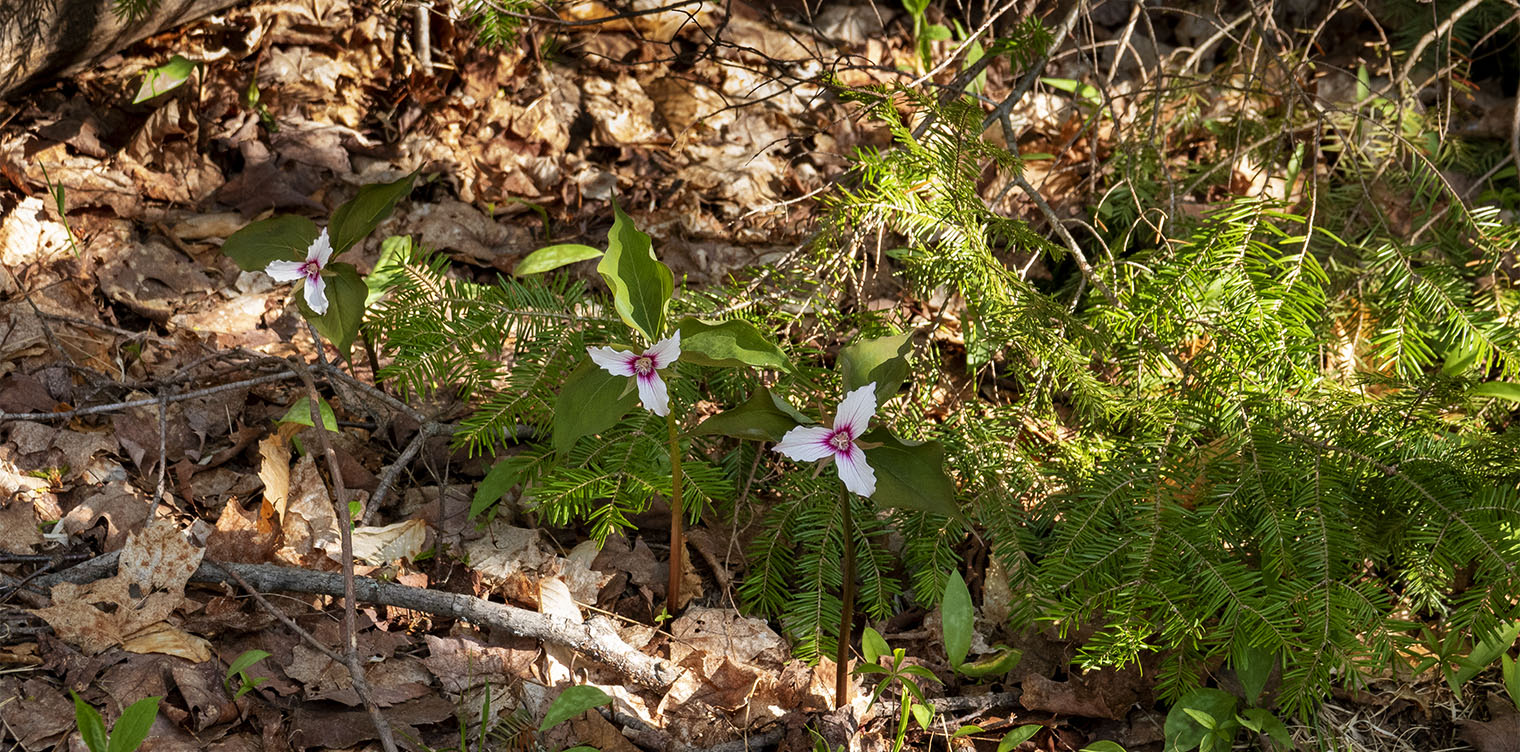
Painted Trillium is classified as a Facultative Upland (FACU) plant, which means that it usually occurs in non-wetlands, but may occur in wetlands. Painted Trillium grows in both full shade or semi-shade and prefers well-drained soil. This species can be found in deciduous and mixed wood forests, growing under northern hardwoods or conifers such as Eastern White Pine, Red Spruce, and Balsam Fir. Painted Trillium is most common in the northern and cooler parts of New York State.
In the Adirondack region, Painted Trillium is found in several ecological communities, including beech-maple mesic forest and pine-northern hardwood forest. The pattern of iNaturalist observations indicates that this plant is found throughout the Adirondack Park.
Painted Trilliums may be seen on many of the trails at the Paul Smith's College VIC. Painted Trilliums are particularly abundant on the western portion of the Heron Marsh Trail, between the floating bridge and the Heron Marsh boardwalk. You can also find Painted Trilliums on the Heaven Hill Trails, the Peninsula Nature Trails, the Heart Lake Trail, and on the Loop Trail at Henry's Woods.
References
Michael Kudish. Adirondack Upland Flora: An Ecological Perspective (The Chauncy Press, 1992), pp. 25, 232.
New York Flora Association. New York Flora Atlas. Painted Trillium. Trillium undulatum Willd. Retrieved 6 May 2017.
United States Department of Agriculture. The Plants Database. Painted Trillium. Trillium undulatum Willd. Retrieved 6 May 2017.
United States Department of Agriculture. Forest Service. Plant of the Week. Painted Trillium (Trillium undulatum). Retrieved 6 May 2017.
Flora of North America. Trillium undulatum Willdenow. Retrieved 6 May 2017.
NatureServe Explorer. Online Encyclopedia of Life. Painted Trillium. Trillium undulatum - Willd. Retrieved 6 May 2017.
Native Plant Trust. Go Botany. Trillium undulatum Willd. Retrieved 26 January 2020.
New York State. Department of Environmental Conservation. New York Natural Heritage Program. Ecological Communities of New York State. Second Edition (March 2014), pp. 119-120, 1210-122. Retrieved 17 October 2015.
New York Natural Heritage Program. 2020. Online Conservation Guide for Beech-Maple Mesic Forest. Retrieved 26 January 2020.
New York Natural Heritage Program. 2020. Online Conservation Guide for Pine-Northern Hardwood Forest. Retrieved 26 January 2020.
New York State. Adirondack Park Agency. Preliminary List of Species Native Within the Adirondack Park Listed Alphabetically by Scientific Name and Sorted by Habit. Volume 1. Updated 10.23.2006, p. 40. Retrieved 26 January 2017.
USA National Phenology Network. Nature’s Notebook. Trillium undulatum. Retrieved 7 May 2017.
Connecticut Botanical Society. Painted Trillium. Trillium undulatum Willd. Retrieved 6 May 2017.
Lady Bird Johnson Wildflower Center. Trillium undulatum Willd. Retrieved 6 May 2017.
iNaturalist. Adirondack Park Observations. Painted Trillium. Trillium undulatum. Retrieved 26 January 2020.
Gary Wade et al. Vascular Plant Species of the Forest Ecology Research and Demonstration Area, Paul Smiths, New York. USDA Forest Service. Research Note NE-380, p. 4. Retrieved 22 January 2017.
Mark J. Twery, et al. Changes in Abundance of Vascular Plants under Varying Silvicultural Systems at the Forest Ecosystem Research and Demonstration Area, Paul Smiths, New York. USDA Forest Service. Research Note NRS-169. Retrieved 22 January 2017, p. 8.
Plants for a Future. Trillium undulatum - Willd. Retrieved 6 May 2017.
University of Michigan. Native American Ethnobotany. A Database of Foods, Drugs, Dyes and Fibers of Native American Peoples, Derived from Plants. Trillium undulatum Willd. Retrieved 6 May 2017.
Ruth Schottman, Trailside Notes: A Naturalist's Companion to Adirondack Plants (Adirondack Mountain Club, 1998), pp. 61-64.
Anne McGrath. Wildflowers of the Adirondacks (EarthWords, 2000), p. 8.
Doug Ladd. North Woods Wildflowers (Falcon Publishing, 2001), p. 84.
Lawrence Newcomb. Newcomb's Wildflower Guide (Little Brown and Company, 1977), pp. 124-125.
Roger Tory Peterson and Margaret McKenny. A Field Guide to Wildflowers. Northeastern and North-central North America (Houghton Mifflin Company, 1968) pp. 212-213.
William K. Chapman, et al. Wildflowers of New York in Color (Syracuse University Press, 1998), pp. 2-3.
National Audubon Society. Field Guide to North American Wildflowers. Eastern Region. (Alfred A. Knopf, 2001), pp. 617-618, Plate 40.
Nancy G. Slack and Allison W. Bell. Adirondack Alpine Summits: An Ecological Field Guide (Adirondack Mountain Club, Inc., 2006), p. 27.
Allen J. Coombes. Dictionary of Plant Names (Timber Press, 1994), p. 184.
Ellen Rathbone, “Stinking Benjamin: A Trillium That By Any Other Name Would Still Smell as Sweet,” Adirondack Almanack, 17 April 2010. Retrieved 7 May 2017.
Cynthia Huebner, et al, “Restoration of three forest herbs in the Liliaceae family by manipulating deer herbivory and overstorey and understorey vegetation,” Plant Ecology & Diversity, Volume. 3, Number 3 (October 2010), pp. 259–272. Retrieved 6 May 2017.
